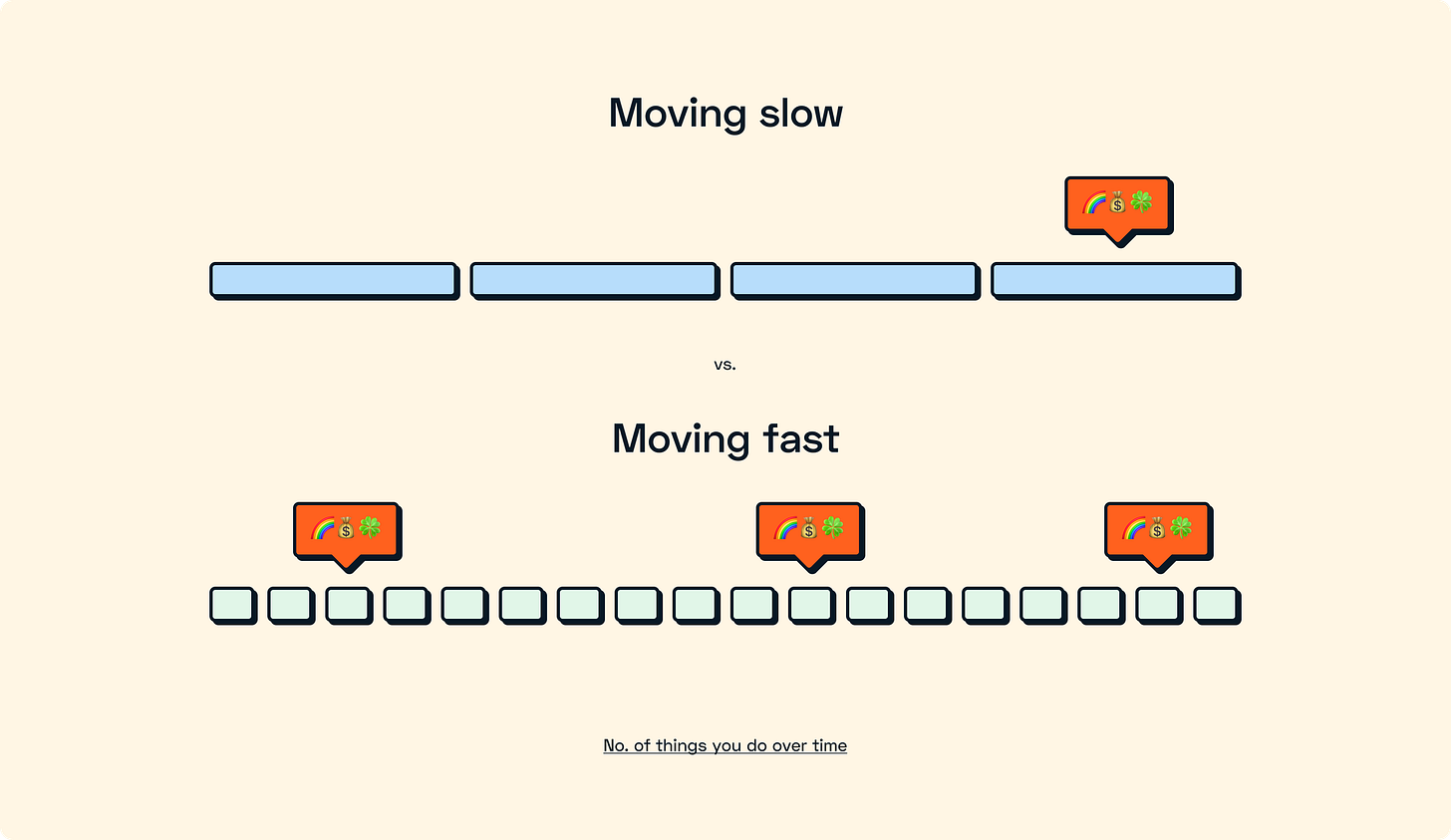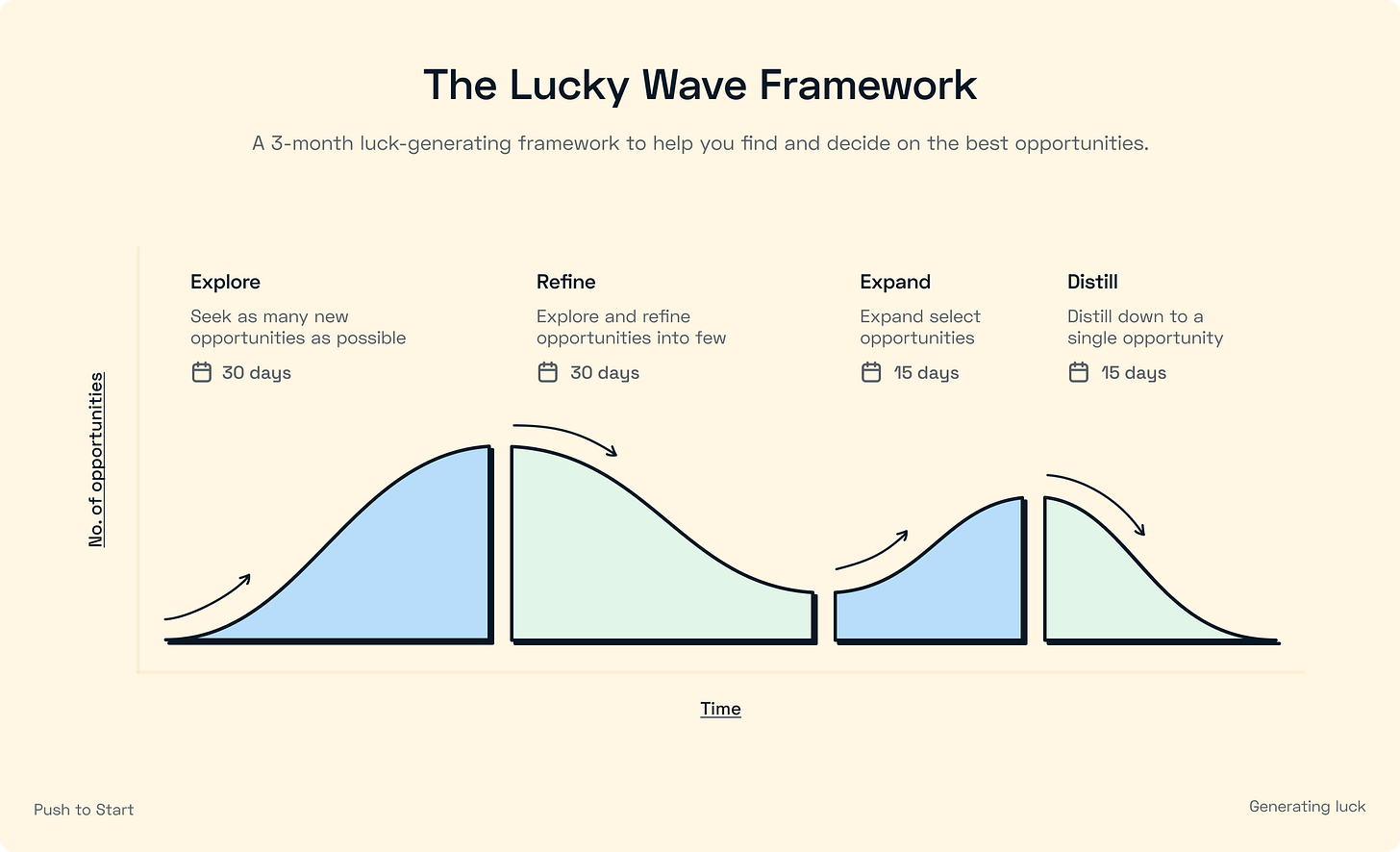Feeling lucky?
Luck plays a huge role in the success of startups. Probably more than you think. But what exactly is luck, can you increase it, and where do you find it?
Luck is a taboo topic in the startup world. Because well, it’s not wise to hedge a bet on it. Instead, we focus on what we can control.
There’s a wealth of information out there helping startups with best practices, mistakes to avoid, and things to focus on. But if we were to distill the major contributing factors of a startup’s success into a few points, they’d look something like:
Market (inc. timing)
Team
Luck
Product is somehow weaved in there, but it often changes dramatically, so the dependency falls back on the team.
You can definitely optimize the first two, but what about the third? Can you control it?
The short answer is ‘no’. The longer answer is ‘no, but you can increase it’.
So how do you get lucky?
Let’s get into it.
Luck in startups
“Luck Is What Happens When Preparation Meets Opportunity”
– Seneca
The truth is that skills are only a part of it. Luck plays a huge role in the success of startups. There are first-time founders (even first job ever… *cough* Bitpanda) that hit unicorn status, and other 2nd, 3rd, and 4th time founders that never get into the 1st gear.
Luck often plays a big role in most things, good or bad.
For example, a science article by biologists Tomasetti and Vogelstein (2015) concluded that “only a third of the variation in cancer risk among tissues is attributable to environmental factors or inherited predispositions. The majority is due to bad luck.”
The paper sparked controversy over the accuracy, but the concept remains… ‘luck’ plays a role.
Just as it does in your startup.
What is ‘luck’?
Luck has many definitions, and means something slightly different to each and every person. Some consider it to be completely unforeseeable and unknowing events of good fortune, whilst others consider it to be favorable outcomes within slim chances. For the purpose of this post, let's define luck as the unexpected component of performance. In other words… a nice surprise.
A surprise that is reasonable to expect a different outcome, if history were to repeat itself again.
Let’s take the power of serendipity. You want to meet a co-founder? Proactively put yourself in the right spaces – events, hubs, etc. The likelihood of a serendipitous match is far more likely. But the outcome changes each and every time.
Increasing luck
Let’s look at the various principles and activities you can use to increase your luck, as well as a personal framework I've been using over the years to become the “lucky guy”.
How to increase your luck
There are 3 main principles you can follow to increase your luck. These are:
Acknowledge facts, but exude confidence and optimism
Most founders are not only passionate, but extremely attached to their product. Passion is great, but it must be backed by facts. Do not fall into the trap of persistence when you ignore every fact in front of you. Be confident and optimistic about the future, despite harsh realities.
For example, if you’ve been trying to sell your solution for years, and no one has bought it, then don’t focus on the usage. Focus on the fact that it is not commercially desirable. Move on.
Stay in market for as long as possible
The biggest differentiator is time. The longer you stay at it, the more ‘lucky breaks’ you expose yourself too. Keep lean, and prolong your runway as long as possible. But, be aware of point 1. The facts.
Have a need for speed
The faster you move, the more lucky breaks you’re exposed to. Good is better than perfect. With everything you do, you’re only one potential step away from good luck. So, do more.
My co-founder often says “you are only ever one decision, one opportunity, one conversation away from being on a completely different trajectory”.
There are also several other regular activities you can do to indirectly increase your luck. These are:
Network as much as possible
Attend events, go out, host parties, meet people, pitch ideas and genuinely be friendly. Approach this from an angle of curiosity. Leave an impression.
Do hard and uncomfortable things
Even if you’re absolutely certain it won’t work out, do it anyway. Get comfortable with doing hard things, regularly. Luck happens mostly when effort and timing align.
Be incredibly vocal
Talk to people. Both in person and online. Tell them about your thing. Ideate and collaborate. Take every opportunity you have to ‘publish’, without the fear.
We now call this ‘building in public’, and there is a reason why it’s so popular.
Help, without expectation of return
If you know me, you know I live by this. Offer help wherever and whenever you can. Do not expect anything from it. It often comes full circle, and creates opportunities you wouldn’t even dream of.
Be curious, be humble
Approach every conversation and situation with curiosity and modesty (especially in Australia). No one helps the guy that has it all. People help those in need. Startups are always in need.
Just ask
Too many are afraid of asking for what you want, or even for help. It’s in most people's nature to give. Worse case they say ‘no’, which is often followed with a ‘but’ that includes something valuable.
Riding the luckiest wave
Back in 2018, I created an accidental framework for generating ‘luck’ (aka opportunities) and have been using it ever since. We’ll get to the story on how it came about, but first let me explain.
Based on sprint methodologies, you run activities in cycles. They’re a little longer than your average ‘sprint’, but they’re designed to fit in with your everyday work/life and not be too disruptive.
It’s used primarily in times where you or your startup feels stuck. Like you’re going sideways or backward.
But, you can also use it to ‘pivot’. A relatable example is the early pivots of both Brex and Retool during their Y Combinator stay. They quickly explored dozens of opportunities, refined and landed billion-dollar products (enjoy that oversimplification!).
Back to that story.
The short version
After a low period of my life, I spent about a month anxiously chasing around opportunity after opportunity during my early twenties, looking for every. single. option. to do something more with my life. Because of a situation I put myself in.
These were in areas like art, coding, print, design, filmmaking, and augmented reality.
Out of these, I had countless lucky ‘opportunities’ that weren’t related to the above areas, but came from them. I explored a few. Tested, tried and transformed. Put my energy into one. Ideated, negotiated, and parlayed. A month later I went from $1,300 in savings, to just under $100,000. Granted not huge, this was definitely life-changing at the time.
Here’s how it works.
Stage 1 – Exploration
Over the next 30 days, you’re going to go far and wide, searching for as many new opportunities as possible (use above activities to seek opportunities). Keep in mind, these don’t have to be directly correlated to what you’ve necessarily been doing. Broaden your net to surrounding, or even distant areas. The purpose of this stage is purely to explore.
For example, you may be a retail payments platform, but decide to explore sports stadium payments during this stage. How about digital receipts? Or even a point of sale?
The goal here is volume. Don’t dig deeper, and absolutely do not pursue any further than a spell binding conversation. You know those ones where you keep building on each other's thoughts? Yeah, those ones. Just spend the 30 days identifying as many as possible.
Create a definition of ‘opportunity’, then move on.
For example, an opportunity may be defined as a new potential pathway based on a prospect's verbally communicated idea. No more. The end.
Set a target then run. A note that having a target is very important.
For example, 10 new opportunities in 30 days.
You will find that you won’t just have 10 opportunities. You’ll have a good 15 or more. The efforts compound and create new connections. In turn, you’ll get even more opportunities across your desk. This is ‘luck’.
Stage 2 – Refinement
Once you’ve hit your 30 days (and your target!), then spend the next reviewing, researching, discussing and testing. With the primary purpose of gathering enough information to make a better decision.
Take this seriously. Look at the past and projected performance of players in the space.
Stage 3 – Expansion
Now, for the next 15 days you’re going to take the select few, and expand them until they become more appetizing. This means a tonne of ideating, negotiating and collaborating. It’s important that you don’t just take the opportunity and move on it with desperation. Hence why you work on multiple at once. Firstly, you lessen the likelihood of getting attached, and secondly, when one (or more) falls over from pushing too hard… Well, eh. Doesn’t matter.
For example, if a prospect noted that they would use a particular product if you built it, then push a little more and see if they would co-fund the development (or invest).
Stage 4 – Distilment
Now comes the process of elimination. By this time you hopefully have a good 2 or 3 attractive opportunities. Choose, go forth and conquer.
60 days ago, you started with nothing. 60 days later, you have an incredibly ‘lucky’ opportunity, you otherwise wouldn’t have had. Upon reflection, what has just happened had a marginal chance of occuring.
There is your luck.
Avoiding luck
If you ever find yourself saying “they’re just lucky” or “you’re so lucky”, it’s probably because you’re doing things to avoid it. You’re positioning yourself in a way where luck does not cross your path. Luck does not come to you – you go to luck.
So, let’s get a few things straight.
You’re not likely to get lucky by sitting at home all the time.
You’re not likely to get lucky by shielding your work from the world.
You’re not likely to get lucky by avoiding risk.
So now we have that straight, let’s look at some common mistakes founders make that are direct causes of avoiding luck.
Building in isolation (even among a team)
Stealth mode is cool, but please involve customers. If you spend months (or years) building something only among you and your team, you’ll often miss the mark.
Involve lots of people, early and often.
Asking bad questions
There are good questions and bad questions. Learn all about them in The Mom Test. If you ask a bad question, you often limit responses to narrow pathways, whereas good questions lead you to many possibilities.
Learn to ask good questions.
Being overly confident
When you’re too confident about a particular matter, you’re closing potential opportunities based purely on how difficult you are to interact with. You’ll be placed in the ‘too hard’ basket and met with strangely positive comments just to end conversations.
Founders often do this by going straight into ‘pitch mode’.
They ‘like it’ not because it’s great, they like it because they don’t want to argue with or upset you.
Go out there and get lucky. Your success is counting on it.
If you enjoyed this or learned something, then please subscribe. If you know anybody that would get value from it, then please share. Your support goes a long way in helping me arm the next generation of founders with the tools to win.
How was this post?
Reply to this email with one of the following:
🔥 – I loved it!!
👍 – Good, not great
👎 – Could be better (let me know in your email)
For the love of startups,
Tim









